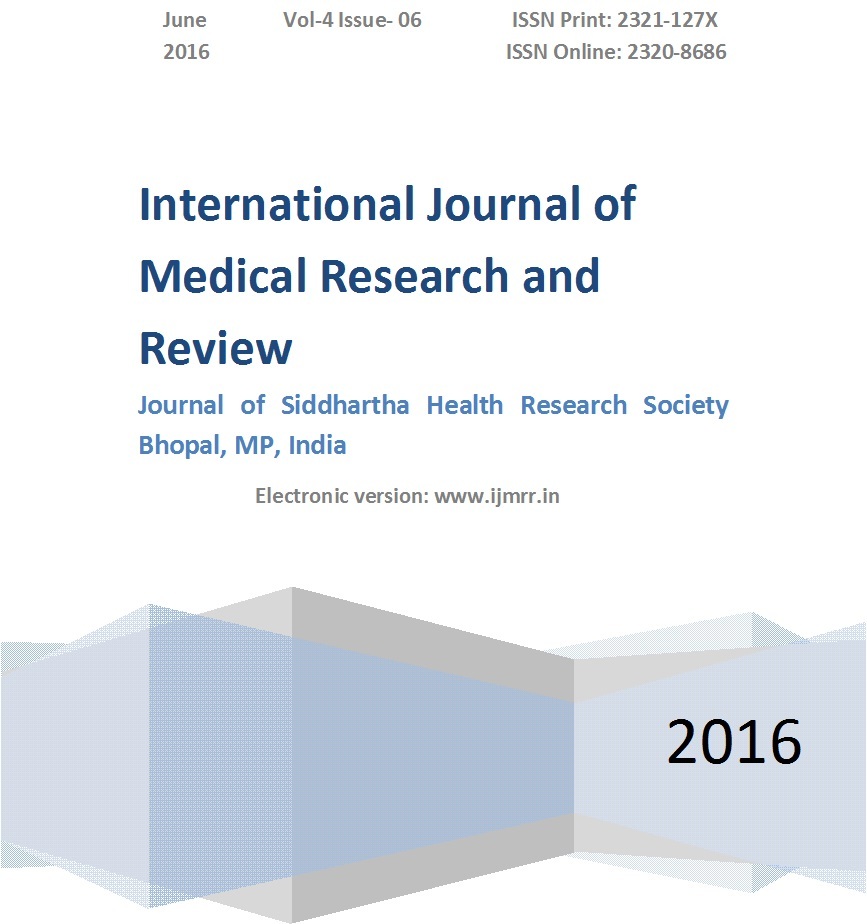Correlation between central foveal thickness as measured by OCT andHbA1c level in diabetes retinopathy
Abstract
Objectives: To evaluate the correlation between Glycosylated Haemoglobin (HbA1c) level and central foveal thickness measured by Optical coherence tomography (OCT) in patients with type 2 diabetes mellitus.
Materials and methods:This was a retrospective single center study of 6 month duration including patients of pre-proliferative stage of type 2 diabetes mellitus. Clinically significant macular oedema (CSME) was diagnosed by using OCT. OCT examination by ‘RT optovue, Fremont, CA’ and HbA1c measured by specific high-pressure liquid chromatography methods. If patient have both eye macular oedema, eye with thicker macular oedema was used for statistical analysis. Exclusion of patients who received intraocular surgery, cataract surgery,pars plana vitrectomy, Severe vitreous haemorrhage,etc.
Results:One hundred four eyes of 104 patients were included in this cross-sectional study. The mean Age ±SD was 62.3±8.1 years (range, 40–77 years). Mean value of HbA1c was 7.8%±1.4% (range, 5.1%–12.1%). Mean DM duration was 11.2±5.5 years (range, 1–30 years). Mean central retinal thickness was 257.1±79.3 μm (range, 151–526 μm). Univariate analysis was significant with HbA1C level (7 or over) (P=0.005). Not statistically significant with Sex (P=0.78), Right or left eye (P=0.59).
Conclusion:Patients with HbA1c of 7% or above had an increase in macular thickness as measured by OCT in shorter DM duration (< 10 years). Its association with macular oedema is statistically significant. Good sugar control decreased the risk of diabetic macular oedema.
Downloads
References
2. Hee MR, Puliafito CA, Wong C, Duker JS, Reichel E, Rutledge B, et.al Quantitative assessment of macular edema with optical coherence tomography Arch Ophthalmol. 1995 Aug;113(8):1019-29.
3. Klein R, Klein BE, Moss SE, Davis MD, DeMets DL. The Wisconsin epidemiologic study of diabetic retinopathy. III. Prevalence and risk of diabetic retinopathy when age at diagnosis is 30 or more yearsArch Ophthalmol. 1984 Apr;102(4):527-32.
4. Pradeepa R1, Anitha B, Mohan V, Ganesan A, Rema M. Risk factors for diabetic retinopathy in a South Indian Type 2 diabetic population--the Chennai Urban Rural Epidemiology Study (CURES) Eye Study 4. Diabet Med. 2008 May;25(5):536-42. doi: 10.1111/j.1464-5491.2008.02423.x. Epub 2008 Mar 13.
5. The Diabetes Control and Complications Trial Research Group. The effect of intensive treatment of diabetes on the development and progression of long-term complications in insulin-dependent diabetes mellitus. N Engl J. Med. 1993 Sep 30;329(14):977-86
6. UK Prospective Diabetes Study (UKPDS) Group. Intensive blood-glucose control with sulphonylureas or insulin compared with conventional treatment and risk of complications in patients with type 2 diabetes (UKPDS 33). Lancet. 1998 Sep 12;352(9131):837-53. Erratum in: Lancet 1999 Aug 14;354(9178):602.
7. Tan CS, Chew MC, Lim LW, Sadda SR1. Advances in retinal imaging for diabetic retinopathy and diabetic macular oedema. Indian J Ophthalmol. 2016 Jan;64(1):76-83. doi: 10.4103/0301-4738.178145.
8. Retinopathy and Nephropathy in Patients with Type 1 Diabetes Four Years after a Trial of Intensive Therapy. The diabetes control and complication trial /epidemiology of diabetes interventions and complication research group . N Engl J Med. 2000 May 4;342(18):1376.
9. Chew EY, et.al ACCORD Study Group and ACCORD Eye Study Group. Effects of medical therapies on retinopathy progression in type 2 diabetes. N Engl J Med. 2010 Jul 15;363(3):233-44. doi: 10.1056/NEJMoa1001288. Epub 2010 Jun 29.
10. Beulens JW1, Patel A, et.al, AdRem project team; ADVANCE management committee. Effects of blood pressure lowering and intensive glucose control on the incidence and progression of retinopathy in patients with type 2 diabetes mellitus: a randomised controlled trial; Diabetologia. 2009 Oct;52(10):2027-36. doi: 10.1007/s00125-009-1457-x. Epub 2009 Jul 25.
11. Early worsening of diabetic retinopathy in the Diabetes Control and Complications Trial. Arch Ophthalmol. 1998 Jul;116(7):874-86.
12. Cunha-Vaz J, Ribeiro L, Lobo C. Phenotypes and biomarkers of diabetic retinopathy Prog Retin Eye Res. 2014 Jul;41:90-111. doi: 10.1016/j.preteyeres.2014.03.003. Epub 2014 Mar 26.



 OAI - Open Archives Initiative
OAI - Open Archives Initiative


